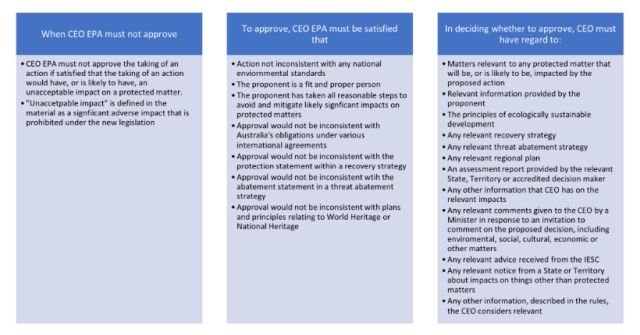- within Compliance topic(s)
- with Inhouse Counsel
2024 is tipped to be a big year for environmental law reform, as the Commonwealth Government prepares to introduce legislation to replace the existing Environment Protection and Biodiversity Conservation Act 1999 (EPBC Act).
While draft legislation is yet to be introduced, the Department of Climate Change, Energy, the Environment and Water (DCCEEW) has been consulting about the proposed reforms, with some of the consultation papers released for public comment by 30 March 2024.
Snapshot
- The EPBC Act is expected to be repealed and replaced with
legislation that:
- Creates a new, independent, Environment Protection Agency with responsibility for assessing applications for approvals, administering approvals and compliance and enforcement;
- Creates Environment Information Australia, which is responsible for managing environmental data;
- Provides for new Nature Positive laws, which replace the existing assessment and approvals process under the EPBC Act, underpinned by national environmental standards;
- Sets out transitional provisions for the replacement legislation and consequential amendments.
- Some draft National Environmental Standards have been released
as part of the consultation, comprising national environmental
standards for:
- Matters of national environmental significance;
- Restoration actions and contributions (i.e. offsets);
- Data and information;
- Community engagement and consultation.
- Consultation is expected to be ongoing into 2024.
- You can read more about the future of environmental offsets in our earlier blog post.
Background
The EPBC Act mandates an independent review of the operation of the Act and the extent to which it achieves its objectives at least every 10 years. The last independent review of the EPBC Act, undertaken by Professor Graeme Samuel AC and presented to the government in 2020, concluded that the EPBC Act was "ineffective and inefficient" and observed that Australia's natural environment is in a state of decline.
In response, the government committed to reform, outlined in the Nature Positive Plan, a series of public webinars, and most recently, the release of part of the consultation papers. The recently released consultation papers are focussed on the proposed assessment and approvals pathways.
What we know
The Commonwealth government is embarking on complex reform to the EPBC Act. At this stage draft legislation has not been released. A series of consultation papers have been developed outlining the proposed reforms and inviting feedback.
The information in this post reflects the current proposal as it affects approval pathways. We expect that changes will be made following the consultation process, and as the legislation continues to be developed.
What stays the same?
The fundamental requirement of the EPBC Act – that a proponent cannot take an action that the proponent thinks has, will have or is likely to have a significant impact on a matter of national environmental significance – remains the same.
It is not proposed that there will be fundamental changes to the existing matters of national environmental significance. The proposed changes to expand the water trigger to apply to unconventional gas has already occurred with the passage of the Nature Repair Act 2023.
Introducing a national environmental protection agency
In a significant shift for legislation that is centred on Ministerial decision making, a new federal government agency will be responsible for assessing project proposals, making decisions and post-approval compliance and enforcement.
The proposal is to establish Environment Protection Australia (EPA). The consultation papers available publicly do not contain much detail about how the EPA will operate, but the detail regarding single approvals confirms that proponents whose proposed actions will have a significant impact on a protected matter will apply to the EPA for approval to take the action, rather than the Minister.
Approval pathways
The consultation paper contemplates two assessment pathways:
- Low impact pathway– which applies where a proponent is relatively certain that their action is not likely to have a significant impact on a protected matter. In those circumstances, a proponent will be able put forward the proposed action to the EPA and receive confirmation that either a federal environmental approval is not required, or that the proposed action will need to progress through the standard pathway for approval to take the action; or
- Standard pathway, which is where an approval is required to take an action as the proposed action is likely to have a significant impact on a matter of national environmental significance.
Applications must be lodged with EPA, who will be responsible for deciding to accept the application, and for processing and deciding the application (including the application of conditions).
Decision making timeframes are an existing concern under the EPBC Act, and while the consultation material sets out more limited timeframes for decisions on applications, those timeframes do not start to run until the application is accepted, and can be stopped in some circumstances. Applications will be required to be frontloaded, with compliance with the national environmental standards able to be demonstrated, including upfront community consultation.
Application process
The proposed application and assessment process is contains multiple steps, with a focus being on frontloading of application, assessment and consultation requirements before an application can be accepted, and timeframes commencing to run. The process briefly includes:

Decision-making for applications
The consultation material provides for a multi-tiered approach to decision making by the EPA. The approach to decision making is proposed to be as follows:

The EPA CEO has power to attach conditions to approvals where an action would, or is likely to, have a significant impact on a protected matter and the condition is necessary to protect a protected matter or avoid, mitigate or repair damage or compensate for damage. Conditions for financial contributions cannot be attached without consent of the approval holder.
Conditioning powers would specifically allow conditions to be imposed to compensate for damage, including by allowing the payment of a restoration contribution of a specified amount.
Ministerial powers
The Environment Minister is proposed to have the power to 'call in' certain decisions of the EPA, including for an environmental approval decision at any point up until the day before a final decision is due to be made. The Minister's decision making criteria is proposed to be less prescriptive than that applying to the CEO, and the Minister must publish reasons for electing to make an approval decision and the reasons for the final decision as soon as practicable.
The Minister may also exempt a proposed action from the requirement to obtain federal environmental approval on a national interest basis. "National interest" is defined narrowly and is limited to defence or national security matters and emergencies or threats that is likely to cause significant harm or affect nationally protected matters. The Minister may only consider granting an exemption if the proposed action is reasonably necessary to address an emergency or threat that affects, or is likely to affect, the national interest and the proposed action is time-critical, such that there is likely to be insufficient time to assess the proposal under the usual process.
Climate change considerations in federal environmental approvals
Project proponents seeking federal environmental approvals under both a standard pathway and the low impact pathway will need to submit an estimate of scope 1 and scope 2 greenhouse gas emissions that are likely to be generated by the action. Proponents will also need to provide a proposal outlining how emissions will be managed, as well as proposed management of those emissions including measures required to meet relevant Government requirements.
The National Greenhouse and Energy Reporting Act 2007 (NGERS Act) will continue to be the key legislation which governs greenhouse gas emissions reporting. Under the recent Climate Change Act, the Environment Minister already has obligations to notify the Climate Change Minister of project emissions that are likely to impact the Safeguard Mechanism.
The Nature Positive Plan also indicates that climate change considerations will be a feature of regional planning.
What's next?
More information on the proposed reforms is expected to be released in the coming weeks, with the legislation expected to be introduced in the first half of 2024. DCCEEW is seeking feedback on the reform until 30 March 2024.
The content of this article is intended to provide a general guide to the subject matter. Specialist advice should be sought about your specific circumstances.
[View Source]





